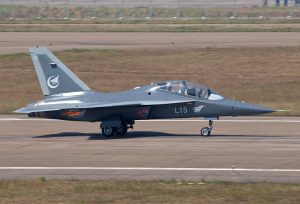The Chinese Defense Ministry has announced that China and the United Arab Emirates will hold their first-ever joint fighter jet drill in China later this month, marking a historic step in the two nation’s defense and security ties.
The move can be seen as another attempt by Beijing to drive a wedge between the United States and Middle Eastern nations following the epoch-making China-brokered Saudi-Iran deal in March.
It can also be seen as a countermeasure against Tokyo, since Japan has been expanding its roster of partners for joint fighter drills.
China’s Ministry of Defense announced on July 31 that based on a previous agreement with the UAE, the air forces of both countries will conduct their first joint air force exercise called “Falcon Shield 2023” in China’s Xinjiang Uygur Autonomous Region in August.
“The move aims to deepen practical exchange and cooperation between the two countries’ militaries and boost understanding and mutual trust,” the Chinese defense ministry said in a press release.
“The first China-UAE joint air force exercise is a good start to enhance military exchanges and cooperation with countries in the Middle East,” the state-owned English-language news Global Times also said, quoting a Chinese military aviation expert.
China announced in February that it had signed a contract to export its domestically developed L-15 training fighter jets to the UAE. At that time, the UAE Ministry of Defense said it plans to purchase 12 L-15s and may purchase an additional 36 of the same type in the future. The L-15, or a supersonic fourth-generation fighter, is also known as the JL-10.
The UAE has been traditionally pro-Washington since its independence from the United Kingdom in 1971. American troops have been stationed there for decades, especially during and after Operation Desert Storm in 1991 when the UAE hosted U.S. forces to support the liberation of Kuwait.
However, in recent years, the so-called “Shale Gas Revolution” has made the United States no longer dependent on Middle Eastern oil, weakening its diplomatic presence in the region. China, the world’s largest importer of crude oil, is now trying to drive a wedge between Washington and Middle Eastern oil-producing countries to strengthen its own influence there.
Meanwhile, the Japan Air Self-Defense Force (JASDF) is also strengthening cooperation with other countries, keeping in mind the Chinese military, which has been increasingly intensifying military activities around Japan. The JASDF conducted its first joint fighter training with the German Air Force in September 2022, with the Indian Air Force in January this year, and with the French Air and Space Force in July.
In addition, the JASDF will hold joint drills with the Italian Air Force from August 2 to 10 at Komatsu Air Base and its surrounding airspace in Ishikawa Prefecture, on Japan’s central west coast. Four F-15 aircraft from the JASDF and four F-35A stealth fighters from the Italian Air Force, among other aircraft, will participate.
The Ministry of Defense in Tokyo plans to deploy four F-35As to Komatsu Air Base in fiscal year 2025, and so the JASDF aims to conduct various tactical exercises with a strong focus on a potential future conflict.
In addition, Japan and Italy are working with the United Kingdom on joint development of a next-generation fighter. According to the joint statement from the prime ministers of the U.K., Italy, and Japan announced in December last year, they are deepening their cooperation as like-minded countries, which advocate “a free and open international order based on the rule of law” and “share common values such as freedom, democracy, human rights, and the rule of law.”

































